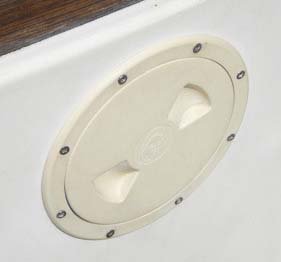Capt GB
Member
My 400 Mainship trawler has a Kohler 8.5 KW generator installed in a sound box and mounted under the cockpit flooring. I have a fair amount access to the gen-set by removing the sound box's side access panels.
The problem is the sound box's top access panel only clears the bottom of the cockpit floor by about 1/16" and is not removable. Furthermore, the pressure cap is mounted on top of the engine and is compressed into the sound box's thermal insulation making it non accessible from above or below the sound box when the side panels are removed.
By rendering the pressure cap not accessible, the manufacturer has all but limited the end user (me) from being able to add or change the coolant to the engine.
I've tried adding coolant to the reserve tank, but to get the pressure cap (double valve and seat) to open, the engine has to be started and allowed to automatically shut down on "Loss of Coolant". This pulls a vacuum and allows the liquid to siphon from the reserve tank back into the engine. However, this only allows a few ounces of coolant to enter the engine at a time, thus requiring multiple restarts to add any appreciable amount of coolant (not acceptable).
Currently, I'm considering cutting an access hole on the cockpit floor and sound box (Not easy to do and I really don't want to do it for obvious reasons).
Has anybody ever had the same problem? How did you address it? Any suggestions would be helpful,
Thanks!
Capt GB
The problem is the sound box's top access panel only clears the bottom of the cockpit floor by about 1/16" and is not removable. Furthermore, the pressure cap is mounted on top of the engine and is compressed into the sound box's thermal insulation making it non accessible from above or below the sound box when the side panels are removed.
By rendering the pressure cap not accessible, the manufacturer has all but limited the end user (me) from being able to add or change the coolant to the engine.
I've tried adding coolant to the reserve tank, but to get the pressure cap (double valve and seat) to open, the engine has to be started and allowed to automatically shut down on "Loss of Coolant". This pulls a vacuum and allows the liquid to siphon from the reserve tank back into the engine. However, this only allows a few ounces of coolant to enter the engine at a time, thus requiring multiple restarts to add any appreciable amount of coolant (not acceptable).
Currently, I'm considering cutting an access hole on the cockpit floor and sound box (Not easy to do and I really don't want to do it for obvious reasons).
Has anybody ever had the same problem? How did you address it? Any suggestions would be helpful,
Thanks!
Capt GB
Last edited:

